#anti japanese sentiment
Explore tagged Tumblr posts
Text
it wasn't enough that arizona's japanese internment camps were placed on gila river indian community and colorado river indian tribes' land as "reservations within reservations" (and against the desires of GRIC.) now i get to learn that chinese and japanese immigrants evaded the chinese exclusion act by traveling first to mexico and then to the u.s., entering through o'odham land, through the late 1800s own flavor of "prevention through deterrence," while the u.s. used what is by all rights a diverse and abundant desert to kill them, just as they do latine migrants today. and now i feel like i have to tell everyone i know about this because nobody told me. our fates as illegal immigrants are so tightly bound up i want to scream.

from Peoples of a Sonoran Desert Oasis by Jared Orsi
#(puts my entire fist in my mouth and bites down)#my family traded it all for the model minority myth and for what. to be just as yoked with a false sense of superiority.#content warning: colonization#content warning: anti-immigrant sentiment#content warning: anti-latino racism#content warning: anti-asian racism#content warning: anti-indigenous racism#content warning: japanese internment era#content warning: chinese exclusion act
11 notes
·
View notes
Text
Discussion about racism in enstars is so braindead on social media tfw there are like 2 people I can talk about my Nuanced Opinions With
#ramblings#i also hate people acting like this is a Western Fandom exclusive problem like#😂🖕 you are ignoring anti blackness and anti indigenous sentiments on purpose at this point#and japanese propaganda has just done such a good job at erasing their indigenous peoples to the outside world
5 notes
·
View notes
Text
me, clueless: i wonder what i should watch on my crowded train ride to kyoto. hmm, i’ve never watched the 1943 batman serials, and it’s all on youtube! nice let’s watch some historic batman media. ok let’s go, chapter 1
video reaches 9:21 minute mark

#um#has anyone else watched these serials#no wonder no one ever ever mentions these serials#holy shit#government agent bruce wayne from los angeles#spoiler warning but it has extreme anti-japanese sentiment
3 notes
·
View notes
Text
Blacktober/black editors literally just paint a Japanese character black, either give them black features or maybe keep their Japanese features, but ALWAYS keep their Japanese names or kimonos if they're wearing one
Japanese and other Asian people: Criticize it or even just bring up they're Japanese and to respect Japan
Editors: "Blasians exist!" "Japan hates us look at the stereotypes in your anime! We can reimagine these characters!" use the extremely racist "She gon' be black today" soundbite.
Also editors: Never give them mixed features or specifically clarify they're mixed.

Fandom Problem #4972:
Me seeing art imagining Japanese characters in kimono as Indian characters in sari: Oh cool! Must reblog!
The artist's description: "there I fixed it, now they're POC"
Me: what the fuck?
Commenter on the art: "Japanese people are POC"
Artist's reply: "now they're visibly POC"
Me: what the fuck?
125 notes
·
View notes
Text
one thing i love about my uni is even when the subject we are studying is about far away country or ultra specific phenomenon theres always a book in the syllabus, published by the university, by a member of that country and/or culture, by an expert on that special subject, who happened to attend my university too. who's lived in the same cities i have.
#i just really like reading books by new zealanders on international subjects#the current one is for my post-colonial lit course#the focus for this is specifically on post-colonial writings by koreans#and joanna cho is the author whose poetry book im reading right now.#shes south korean and a new zealander and has lived in both places#and her writing is good at focusing on comfortable moments in time#but also indecision and the fear of making the wrong choices#it also is very good at encapsulating the specific racism so many people from asia are subjected to hete#its very bad. anti-chinese and anti-indian sentiments are held by far too many people. and because of ignorance that gets directed towards#korean japanese filipino and any person who looks ''asian'' enough for someone to let out repugnantly casual racism towards#all in all this has been a good read so far im 1/3 through and i really enjoy her writing style#i think shes my favourite poet ive read in any of the poetry courses ive taken
8 notes
·
View notes
Text
squenix making the nezha chariot a shop item instead of giving it to me for free has to be some sort of anti-chinese sentiment
#neil.txt#i still think its so funny how they made nezha a doman hero in the lore. it's not funny and im not laughing but it's like oh my god lmao#alena once asked me 'why don't you post any of the stuff you say on your private accounts about xiv's politics' well first of all i would b#cancelled for anti japanese sentiment in 5 seconds
2 notes
·
View notes
Text

watched this because it came up in my recommended and after like 2 minutes i decided i needed to be a little hater about it and its wild how badly formatted the argument is. big "reddit i have theories" energy. mfer goes from thesis statement "the government has covered up a snuff film ring" to conclusion "i think these pedophiles knew each other" where's the cover-up man. so many names but you dont even put their pics up on the screen or give us any visual reminders of who the fuck these guys are. audio terrible. did a whole red string conspiracy board and im like

#i do like the one guy getting mad that every time he foia's his own fbi file they write it down in the file#im going to be completely honest i was waiting for the reveal that he was just fucking with the audience which was why i kept watching and#was extremely disappointed to see that no. he was being serious.#ALSO the anti-Japanese sentiment outta nowhere ????????????
0 notes
Text
Allies have no right to bitch about comfort women when they had comfort women themselves

After Hiroshima and Nagasaki: Tragedy and Humiliation.
U.S. and Australian brutalisation of women on the Japanese mainland (Excerpt From Pages 66-69)
All References Are Provided in the Book Itself
“There was a far darker side to the U.S. and allied occupation of Japan, one which is little mentioned in the vast majority of histories – American or otherwise. When Japan surrendered in August 1945, mass rapes by occupying forces were expected… [despite setting up of a comfort women which recruited or otherwise trafficked desperate women to brothels] such crimes were still common and several of them were extremely brutal and resulted in the deaths of the victims. Political science professor Eiji Takemae wrote regard- ing the conduct of American soldiers occupying Japan:
‘U.S. troops comported themselves like conquerors, especially in the early weeks and months of occupation. Misbehavior ranged from black-marketeering, petty theft, reckless driving and disorderly conduct to vandalism, assault, arson, murder and rape. Much of the violence was directed against women, the first attacks beginning within hours after the landing of advanced units. In Yokohama, China and elsewhere, soldiers and sailors broke the law with impunity, and incidents of robbery, rape and occasionally murder were widely reported in the press [which had not yet been censored by the U.S. military government]. When U.S. paratroopers landed in Sapporo an orgy of looting, sexual violence and drunken brawling ensued. Gang rapes and other sex atrocities were not infrequent [...] Military courts arrested relatively few soldiers for their offences and convicted even fewer, and restitution for the victims was rare. Japanese attempts at self-defense were punished severely. In the sole instance of self-help that General Eichberger records in his memoirs, when local residents formed a vigilante group and retaliated against off-duty GIs, the Eighth Army ordered armored vehicles in battle array into the streets and arrested the ringleaders, who received lengthy prison terms.’
The U.S. and Australian militaries did not maintain rule of law when it came to violations of Japanese women by their own forces, neither were the Japanese population allowed to do so themselves. Occupation forces could loot and rape as they pleased and were effectively above the law.
An example of such an incident was in April 1946, when approximately U.S. personnel in three trucks attacked the Nakamura Hospital in Omori district. The soldiers raped over 40 patients and 37 female staff. One woman who had given birth just two days prior had her child thrown on the floor and killed, and she was then raped as well. Male patients trying to protect the women were also killed. The following week several dozen U.S. military personnel cut the phone lines to a housing block in Nagoya and raped all the women they could capture there – including girls as young as ten years old and women as old as fifty-five.
Such behavior was far from unique to American soldiers. Australian forces conducted themselves in much the same way during their own deployment in Japan. As one Japanese witness testified: ‘As soon as Australian troops arrived in Kure in early 1946, they ‘dragged young women into their jeeps, took them to the mountain, and then raped them. I heard them screaming for help nearly every night.’ Such behavior was commonplace, but news of criminal activity by Occupation forces was quickly suppressed.
Australian officer Allan Clifton recalled his own experience of the sexual violence committed in Japan:
‘I stood beside a bed in hospital. On it lay a girl, unconscious, her long, black hair in wild tumult on the pillow. A doctor and two nurses were working to revive her. An hour before she had been raped by twenty soldiers. We found her where they had left her, on a piece of waste land. The hospital was in Hiroshima. The girl was Japanese. The soldiers were Australians. The moaning and wailing had ceased and she was quiet now. The tortured tension on her face had slipped away, and the soft brown skin was smooth and unwrinkled, stained with tears like the face of a child that has cried herself to sleep.’
Australians committing such crimes in Japan were, when discovered, given very minor sentences. Even these were most often later mitigated or quashed by Australian courts. Clifton recounted one such event himself, when an Australian court quashed a sentence given by a military court martial citing ‘insufficient evidence,’ despite the incident having several witnesses. It was clear that courts overseeing Western occupation forces took measures to protect their own from crimes committed against the Japanese – crimes which were largely regarded as just access to ‘spoils of war’ at the time by the Western occupiers.
As had been the case during the war, underreporting of rapes in peace- time due to the associated shame in a traditional society and inaction on the part of authorities (rapes in both cases occurred when Western militaries were themselves in power) would lower the figures significantly. In order to prevent ill feeling towards their occupation from increasing, the United States military government implemented very strict censorship of the media. Mention of crimes committed by Western military personnel against Japanese civilians was strictly forbidden. The occupying forces ‘issued press and pre-censorship codes outlawing the publication of all reports and statistics “inimical to the objectives of the Occupation.”’ When a few weeks into the occupation Japanese press mentioned the rape and widespread looting by American soldiers, the occupying forces quickly responded by censoring all media and imposing a zero tolerance policy against the reporting of such crimes. It was not only the crimes committed by Western forces, but any criticism of the Western allied powers whatsoever which was strictly forbidden during the occupation period – for over six years. This left the U.S. military government, the supreme authority in the country, beyond accountability. Topics such as the establishment of comfort stations and encouragement of vulnerable women into the sex trade, critical analysis of the black market, the population’s starvation level calorie intakes and even references to the Great Depression’s impact on Western economies, anti-colonialism, pan-Asianism and emerging Cold War tensions were all off limits.
What was particularly notable about the censorship imposed under American occupation was that it was intended to conceal its own existence. This meant that not only were certain subjects strictly off limits, but the mention of censorship was also forbidden. As Columbia University Professor Donald Keene noted: ‘the Occupation censorship was even more exasperating than Japanese military censorship had been because it insisted that all traces of censorship be concealed. This meant that articles had to be rewritten in full, rather than merely submitting XXs for the offending phrases.’ For the U.S. military government it was essential not only to control information – but also to give the illusion of a free press when the press was in fact more restricted than it had been even in wartime under imperial rule.
By going one step further to censor even the mention of censorship itself, the United States could claim to stand for freedom of press and freedom of expression. By controlling the media the American military government could attempt to foster goodwill among the Japanese people while making crimes committed by their personnel and those of their allies appear as isolated incidents. While the brutality of American and Australian militaries against Japanese civilians was evident during the war and in its immediate aftermath, it did not end with occupation. The United States has maintained a significant military presence in Japan ever since and crimes including sexual violence and murder against Japanese civilians continue to occur.”
#us war crimes#american war crimes#australian war crimes#tw: assault#tw: racism#tw: rape#anti japanese sentiment#japanophobia#racism#anti asian sentiment
29 notes
·
View notes
Text
also check out this thing that icon haku'un yasutani had to say during ww2 in his dogen zenji to shushogi: We must be aware of the existence of the demonic teachings of the Jews who assert things like [the existence of] equality in the phenomenal world, thereby distorting public order in our nation's society and destroying [governmental] control. Not only this, these demonic conspirators hold the deep-seated delusion and blind belief that ... they alone have been chosen by God and are [therefore] an exceptionally superior people. The result of all this is a treacherous design to usurp [control of] and dominate the entire world, thus provoking the great upheavals of today.
#in general i feel like a lot of people should do more research into prominent zen faces in the west#because you run into shit like this or like the incredibly anti chinese and japanese nationalist sentiments of dt suzuki
1 note
·
View note
Text
Asian/Pacific American Heritage Month: Spotlight on Alma Katsu's THE FERVOR
Celebrating Asian/Pacific American Heritage Month with Alma Katsu!
Today’s guest is Alma Katsu, author of The Fervor, a fantastic novel set in 1944, that tangles the lives of a newspaper reporter, a newly ordained minister, Japanese internees, and a Japanese scientist around a mysterious illness. The narrative alternates among several characters, drawing them together as more is revealed about the illness spreading through the internment camp and the appearance…

View On WordPress
#1944 novel#Alma Katsu#anti-Asian sentiment#Asian/Pacific American Heritage Month#Bram Stoker Award#historical events#internment camps#Japanese Americans#Japanese folklore#Japanese internees#Japanese scientist#mysterious illness#narrative alternates#newly ordained minister#newspaper reporter#racism#Roosevelt&039;s executive order#supernatural elements#The Fervor#United States&039; atrocities#violence
1 note
·
View note
Text
Ok im bored and ran out of good content so fuck it lets do this. Decided not to publicize it for so long bc its difficult.
This is my boldest and most prized contribution to this cursed fandom, as well as my dearest tribute to Tobirama, the best political character ive ever read in fiction, and his anija.
warning - this might not be for people with too heavy leaning on anti-konoha, anti-Hashirama sentiments or ships that's not hashimito or tobirama/konoha, or take the timings and numbers of the databook too seriously.
Hashirama is vaguely hinted to canonically have retired as Shodai years earlier, then married Mito, then lived till 10-20 years after VOTE and died in or before the 2nd War.
Tobirama died first in the 1st War. The scene where he sacrificed himself for his squad happened before the VoTE fight, not after. It's his death that signaled the End.
Hashirama losing his power/ability to lead due to possible depression and keeping a low profile (no one could know how and when the Shinobi God died because village situations, and there were sensors and trackers who could find him) is the reason why he didnt know the motive of the Police Force that Tobirama created, and also struggled with Kurama to the point he needed Mito to LEND him power, when earlier he could beat both Kurama and Madara.
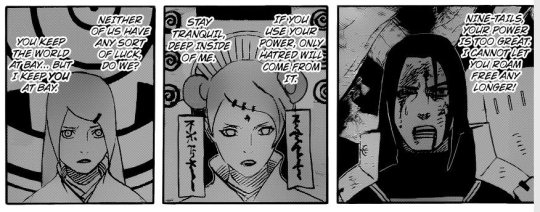

Zetsu made up bullshit about Tobirama burying and letting Madara escape with a clone, based that assumption on Tobirama's reputation of creating weird jutsus involving sacrifices, most likely framing him for his surbodinates' doings, because Tobirama totally never knew Tsunade, possibly never even met Mito and dealt with a jinchuuriki, while Hashirama did both, comparing teenage Sakuras power to Tsunade's.
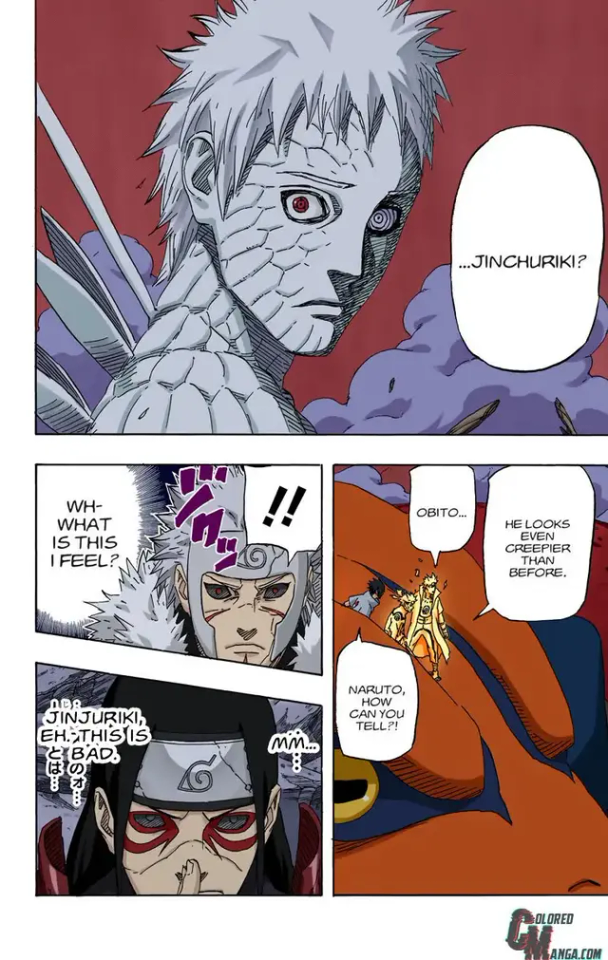

Zetsu also would not have been near there to know what the senju brothers did because they were both sensors that could detect him. Hashirama was the one who buried Madara.
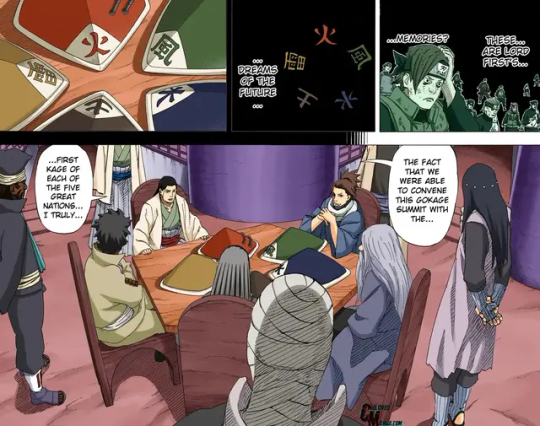
As Onoki said this summit was to end minor conflicts, it happened right after Konoha was founded, not right before the WW. the 2nd kages looked much younger than in the VOTE/WW era. Hashirama likely had other means, more temporary and less effective, to restrain Kurama at this point (his mokuton and necklace) The databook also never said Hashirama died in which war.
Tsunade and Tobirama had no recollection of each other outside Tsunade only calling him distantly 'nidaime' since part 1 and only 'heard' about the ones who killed him.


meanwhile Hashirama was too familiar with tsunade as she with him, and familiar with the village and people, so that he could recall his memories with it despite just having seen it before he died like weve been told.

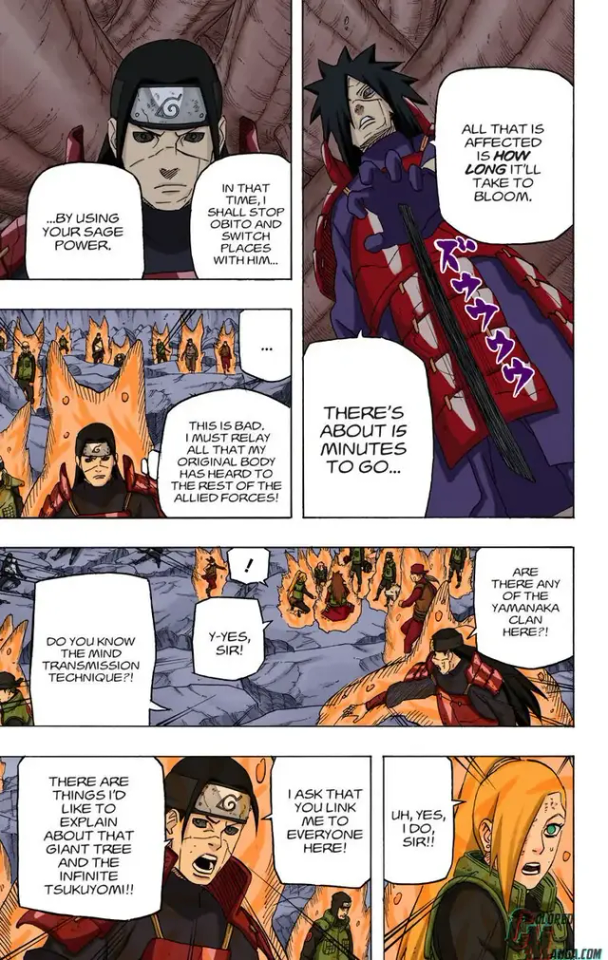
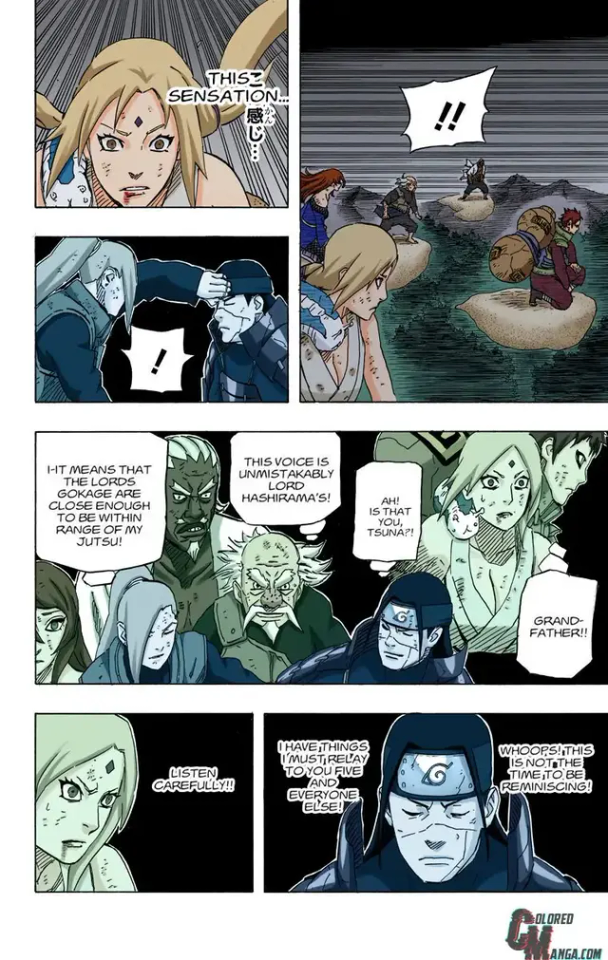

He talked like he's been through 2 wars with them.
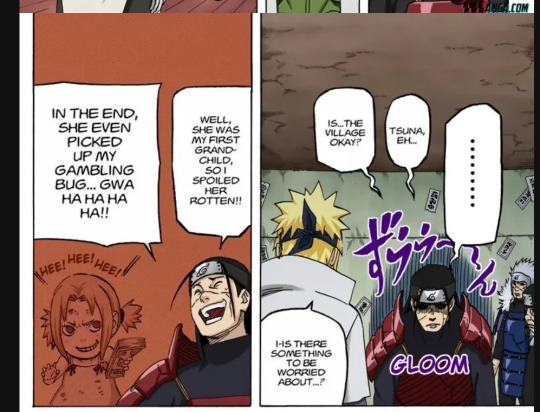
Our second known grandkid of Hashirama was Nawaki, who was 11 years younger than Tsunade. Unless his first son has multiple children in short years which is pure fanfiction, how would he know Tsunade was his 'first' grandkid and how she would turn out 'in the end' if he died when she was this small.
Also the fact that Hashirama didnt wear Konoha headband in the VOTE fight.

But did wear it when he married Mito. Tsunade was not Mito's grand daughter.

As for how he died, its in battle, probably to a nobody mob while protecting his clan or Mitos clan (both conveniently destroyed or disappeared after hes dead). And by the time they killed him and he let them do that, i doubt they even realized or remembered they killed the First Hokage and God of Shinobi. I mean youd think whoever killed him should have been insanely famous, regardless of his power level at the time.
Tobirama said "my role as Second Hokage was to stand between and meditate between brother and Madara while protecting the village" this raised eyebrows because there would have been no one to stand between if he only became Second after Hashirama died and Madara left (forever). Meaning Hashirama was alive when Tobirama became Second, and it had been like that for a long time.

This is what a japanese fan thought of Tobirama's death



Between the two brothers, it makes more sense for the 'normal' one who invented jutsu that defied the law of nature, including
ninja nuclear bombs,
Summoning the dead and giving them infinite chakra
clones only reserved for monster chakra reserves like Naruto with Kurama in him
and a teleportation jutsu that required 5 people in place of an absolute genius like Minato to do- moderately,
rather than a powerful monster with the same annount of chakra as a bijuu AND sage mode that heals himself, to die earlier out of illness.
This is also why Hashirama would ban Tobiramas jutsu and compiled them into HIS scroll seen in the very first chapter - they likely literally shorten ones life. Hashirama wouldnt want random people to drop dead using them...like his brother.
Some more readings on which Japanese samurai characters that have been Kishimoto's references for the founders.
Oda Nobunaga - Hashirama's first concept when he was a scary rugged scarred and big nosed guy, the one who stopped the genenations long wars, unified japan and died right after realizing the dream, but he died partly because of his brutality and crimes in life - he ACTUALLY killed his brother by blood among others of his family who betrayed him. His successor has nickname 'Saru'.
Ashikaga Takauji - Hashirama's later concept, first shogun of his era but softer big brother guy.
Ashikaga Tadayoshi - Takauji's younger brother who stepped up where he couldnt, disagreed with Takauji on politics and died 5 years before his brother did, in defeat but also there are sources that say he suffered some kind of illness before that.
Ko no Moronao - Takauji's close friend who Tadayoshi hated and was later exiled.
More references in Japanese creation mythos involving Izanagi and Izanami, where Izanagi killed his Fire god son Kagutsuchi after Izanamis death, hence his words "my very own child".
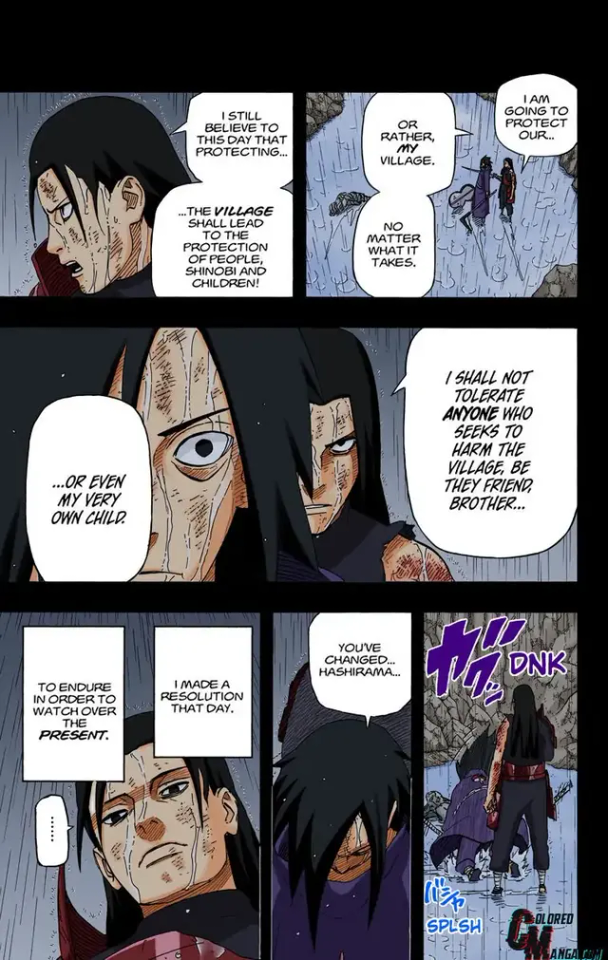
#naruto#naruto shippuuden#meta#meta galore#senju hashirama#senju tobirama#naruto timeline#senju tsunade#japanese history#kishi is a smooth liar
278 notes
·
View notes
Note
blacktober should be not about racebending japanese characters and then alling japanese people anti black and yammering on about how they already have rep (the only time black people go after the japanese too mind you, EVER), but making new black characters or celebrating the pre esxisting ones, redesining offensive characters to be not offensive, and drawing beautiful art of black hair and African, Caribbean, and Creole things. THAT'S CELEBRATION OF BLACKNESS, not STEALING FROM ASIANS, especially not the JAPANESE WHO WERE INTERNED AND STILL DEAL WITH WEIRDOS WHO DEFEND THE NUKES AN STUPID INFLUENCERS BEING RACIST OR CULTURALLY INSENSITIVE LIKE LOGAN PAUL AND JOHNNY SOMALI (Johnny is a prime example of a Japanophobic black person. "Hiroshima Nagasaki Fukushima". Even Koreans he hates as shown with his "Korean War you know what we did to you". A KOREAN MAN had to call him out, and even though Japan targeted Korea this same Korean instead of bootlicking Truman like so many other Asians do, recognied H and N people were victims not "fascists" (black people hate Koreans as much or maybe more than the Japanese)
Blacktober just was used as a "try to make white people mad, but race changing japanese characters"-tober
I mean... Ugghhhh..!
Race-swapping isn’t a bad thing in fanart. It’s not, a lot of the times it can be cool.
But just like the obnoxious trend of ‘lol, I made this popular character trans to draw smut of them; share to make a transphobe mad~’, when people do the thing, not for actual interest, but to ‘make some hypothetical adversary mad, you’re being annoying.
And you get things to the point that people start looking at all art of that nature as being annoying.
40 notes
·
View notes
Note
Do you think Hideaki Anno is right-wing or is it too difficult to tell from his works?
Haha that's a question.
I'll focus on nationalism rather than trying to get into, say, gender politics here, since that's the accusation that most seems to follow Anno around.
Anno's politics are... hard to pin down from his work alone, I think. He's like... a prototypical case of that generation of 'apolitical' otaku that followed after the Anpo generation, with Eva pretty much the definitive statement of the 90s psychological turn. But that said... I can definitely see the argument that there are nationalist themes in some of his works like Gunbuster, though I definitely don't buy every reading in this series (lots of dubious kanji reading). He definitely has that otaku fascination with war machinery and war media (apparently he's a big fan of The Battle for Okinawa and watched it over 100 times), which can easily blend into imperialist ideology.
But there's complications here. For example, the Animekritik series cites the setting of Gunbuster in Okinawa as something formative to the nationalist ideology they are trying to illustrate - in part in relation to the ongoing controversy over American military bases in Okinawa. Anno has at least been on record as saying he's disinterested in Western culture, and I can see the reading of Jung-Freud as an external Other who is shown up by the Japanese girls, somehow simultaneously representing the USSR, Europe and the States. But anti-Americanism in Japan can come in both left and right wing flavours (c.f. Anpo). Communists want the Americans out too! Portraying Okinawa as a military training camp in a Japan-led military coalition certainly comes across as a more nationalist take on that whole matter, but I feel like it's got about the same level of serious nationalist commitment as Doctor Who putting random British people all over space.
When Gainax has played around with nationalist imagery it's usually been in a kind of ironic sendup way - see Ash's writeup about the Aikoku Sentai Dai Nippon controversy, in which Daicon Film staff were disdainful at the accusation that their goofy toku film reflected a genuine nationalist sentiment. While Imaishi takes it further, a lot of Anno's work is also about playfully reappropriating past works. In Anno's case a lot of that is classic tokusatsu, Ultraman in particular, and also Leiji Matsumoto's scifi, notably Space Battleship Yamato, which, well... you know the deal there lol. But it's not so simple to go from that to 'Anno is a nationalist'.
Eva doesn't tend to attract these accusations, but I recall the controversy came back around with Shin Godzilla, though to my mind it's hard to find a straightforwardly nationalist reading of that movie. (It's a film about the experience of the earthquake and Fukushima nuclear plant meltdown, and it's critical of Japan's bureaucracy, but equally one where the JSDF repeatedly get their shit handed to them and civilian infrastructure is what actually stops Godzilla - not to mention Godzilla is painted as quite a tragic figure here!) It all feels pretty tenuous.
I haven't seen as many of Anno's live action films as I'd like, so I can't comment as much on the more recent Shin films, Love & Pop, Shiki-Jitsu etc. And it's always possible for subtler allusions to slip by the anglophone viewer. Still, I don't personally think Anno's post-Gunbuster work is particularly nationalist in outlook. I certainly haven't seen any evidence of him favouring, say, war crime denial, anti-Korean sentiment, remilitarisation, etc etc. - he's definitely not as dubious a figure as someone like Hajime Isayama. But it's not like, anti-nationalist either! It's just kind of hard to read in those terms.
So I lean towards your second option, I'm not convinced he's a nationalist or particularly right wing. He happily associates with Hayao Miyazaki, who's definitely not a right wing guy. But Anno'll also let hilariously cooked stuff like whatever On A Gloomy Night was supposed to be into the Animator Expo. So I don't think he's particularly left wing either, he's no Ikuni! But Anno's fiction is very individual focused, full of psychoanalytic themes and internal conflict. He can vividly portray trauma and complex power dynamics. There's a lot to appreciate in works like Eva from a left-wing angle. I don't really know why this association of nationalism follows him around.
Idk, maybe there's a bunch of interviews I'm missing! Presumably you have a reason for asking this question...
145 notes
·
View notes
Note
feel free to ignore bc i'm an anti but i promise this isn't harassment
been showing interest (against my will) in learning abt this and im just curious. how does loli stuff not equal ped? /genq
and do picky proshippers exist? (those with lots of icks, like not liking anything of animals etc)
scared this response will turn me into a proshipper /hj but ik if it does i'll feel like a freak and go confessing to family and lose relationships w ppl i love LMAO
Hey, pal. I'll answer this in the spirit it's sent, because it seems like you genuinely want to learn and understand.
I'm going to answer your questions in reverse order, because it makes the most sense to do so.
"Are there picky proshippers?"
My pal, my friend, my buddy. "Proshipper" does not mean someone who enjoys dark content, at all. And it certainly doesn't mean "person who enjoys all dark content without exception."
"Proshipper" means someone who doesn't criticize other people for their fictional relationships because they know that they're fictional.
There are LOTS of "picky proshippers". I would dare say that all proshippers are picky in one way or another. The difference between a proshipper and an anti is that a proshipper simply avoids content that they don't want to see. They block, filter, and ignore ships and other content that make them uncomfortable.
There are proshippers who are uncomfortable with shipcest, or with age gaps, or with noncon content, etc.
I'm PERSONALLY very picky. I don't want to see any content that has noncon in it. I'm very picky about what dubcon I consume. I'm extremely squicked out by forced gender content, and by pregnency, and by genderswap fic.
And I just do my best to avoid it.
As for "how does loli not equal pedo"-
First let me make it really clear that I am first of all, personally uncomfortable with a lot of the content that gets labeled "loli", and I am second of all, uncomfortable with using the term "loli" in discussions of what content should or shouldn't be censored, because the people who are agressively "Anti-loli" tend to hold a lot of anti-Japanese racist sentiment.
So this is a difficult subject for me to address.
Let me say clearly that the answer is because fictional under age content is fictional.
It's no worse to be interested in fictional underage sex content than it is to be interested in fictional murder content, or fictional theft content.
It's all pretend. It's make believe. It's not real. Liking something in fiction doesn't mean you have any interest in it in real life.
I hope this answers your question. Please feel free to ask follow up questions if the spirit takes you.
44 notes
·
View notes
Note
Since it's the 1930's and anime didn't exist yet, what is Gangle into in this AU?
Well, considering Anime is just Japanese animation... it did.
But if you're talking about in the modern sense, then yeah, I guess.
The Anime fandom was only really started around the 80s (fun fact: by the same guy who helped start the furry fandom!)
It's set in the mid 40s just after the second world war, so there would have been a lot of anti-Japanese sentiment going around, Japanese animation probably wouldn't be easy to come by in the states even before the war...
So basically, yeah, you're right. Kinda.
They're into comics in this au.
65 notes
·
View notes
Text
They went for Latinos. They went for indigenous people. They went for black people. They went for Arabs. They went for Russians in the Cold War. They went for Jews. They went for Vietnamese, Cambodian, and Laotian people (and demonized the anti war people and hippies against the atrocities done to those people).
Also the Japanese, German, and Italian internment was in the 40s during the war not the 50s. But stil.
Wake up Tronald Dump, your country has a long history of stripping cultures of their rights and even LIVES a lot of the time.

President FDR used the Alien Enemies Act to INTERN AMERICAN CITIZENS in camps into the 1950's. They went for Italians, they went for germansm, but most of all, they went to the AAPI. There are people alived today that remember being in those camps. There are people alive today who have parents and grandparents that were in those camps. We must remember: if we do not learn history, We are doomed to repeat it. We are watching it begin to repeat itself. Do not think for one moment you are safe. Anyone who is of color, anyone who is queer, anyone who has a disability, anyone who is an American Citizen that doesn't agree with MAGA will be throw into camps. That's a promise and its all written down right in front of us.
#vote kamala#japanophobia#germanopobia#anti japanese sentiment#anti german sentiment#anti italian sentiment#italophobia#antisemitism#anti arabism#anti latino sentiment#indigenous rights#anti blackness#anti asian sentiment#anti russian sentiment#slavophobia#anti vietnamese sentiment#anti laotian sentiment#anti cambodian sentiment
27 notes
·
View notes